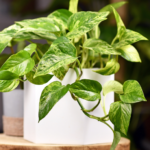Do you love to garden? If so, you might want a compost bin to give you some amazing, enriched soil that helps your garden grow better.
Creating your own nutrient-rich soil is pretty easy. You don’t need much more than a few items from around your home that can work to create the bin that produces this soil for you every year. If you’ve never created your own bin, you’ll want to start small and see how it goes. Once you complete this project and it produces some wonderful soil, you can move up to a more complex system if you want.
Here’s how to make an easy compost bin out of items you probably have in your home right now.
1. Find the right bin
Some people create complex systems for composting, but this process can be done with nothing more than a 30-gallon plastic tote. The tote should have a tight-fitting lid and be at least 24 inches tall. The goal is to keep the soil moist and the critters away, which makes a 30-gallon bin about the right size. Choose a color that works well in your yard. You’ll want it to be as close to invisible as you can make it.
2. Drill holes in the bin
Use your handheld drill and make several small holes in the bottom of your bin to create some airflow. The organic waste needs oxygen to complete the composting process. Sing a 3/16” drill bit you should drill 8-10 holes in the bottom of the container. This is an easy step and makes building your compost bin quick and easy. After drilling the bottom, drill another 8-10 holes in the lid to help the airflow process at the top.
3. Add the brown base to the bin
The composting process requires browns and greens. The browns are dead leaves, twigs, and other fallen items that you find on the ground in the forest. You want to fill the bin about ¼ full o these leaves and twigs to get the brown base set up. The leaves and twigs allow for the airflow and enriched composition of the dirt that will feed your plants and give you the best soil to grow flowers and vegetables every year. You can also use newspaper and cardboard to create your brown base.
4. Add dirt to the bin
Many people are under the misconception that you need worm-filled dirt in your compost bin, but it’s not a requirement. YOU can simply put some topsoil in the container and fill it halfway full of dirt on top of the brown base to give your bin the meat of the compositing process. Worms can help with the process, but you’ll want to separate them from the dirt later, which might not be something you want to do. Just add the dirt on the brown base and let this dirt become enriched with the nutrients from the green layer that goes on top.
5. It’s time for the green layer
The green layer is the food scraps and paper products that will compost into soil nutrients. Not everything you eat can go in the compost bin, which means you should check a guide to ensure you’re putting the right items in your bin to be composted. Some of the most popular items to put in this bin are:
- Fruit and vegetable scraps
- Coffee grounds, coffee filters, tea bags, dryer lint
- Eggshells and nutshells
- Paper or cardboard
- Yard or grass clippings
It’s important to avoid items that should not be put in the bin, including dairy products and pet waste. If you’re unsure about items that can be composted, check the EPA website to learn what you can and cannot put in your bin.
6. Stir up the compost and moisten
Give the materials in your compost bin a small stir with a shovel or stick to make sure the food scraps are covered with dirt. Once done, spray with lukewarm water until its moist, but not soaking wet. Too much water could be a problem if your compost begins to smell.
When is it ready?
Your compost will be ready with the organic materials have broken down and it has an earthy smell to it. The compost bin shouldn’t be warm and should feel about the same temperature as the air. The compost dirt should be dark, crumbly, and not wet or clumpy. This process can take anywhere from a few months to a year, but the time is worth it to give you the amazing soil you’ll use in your gardens.
This post may contain affiliate links. Meaning a commission is given should you decide to make a purchase through these links, at no cost to you. All products shown are researched and tested to give an accurate review for you.




